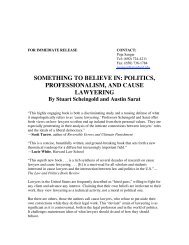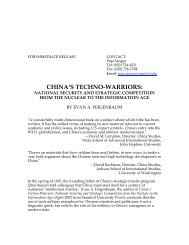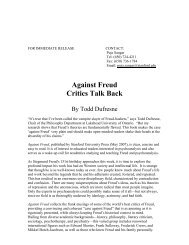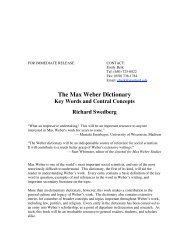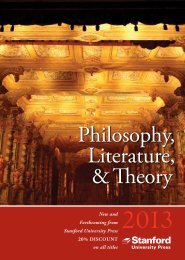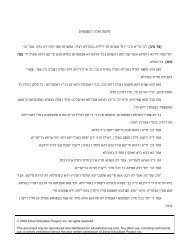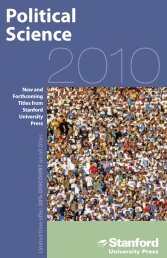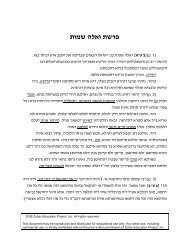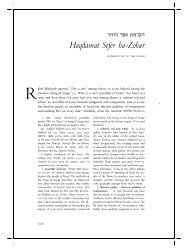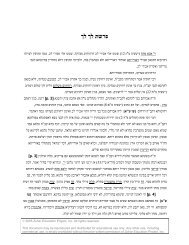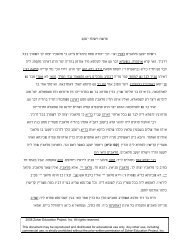Front Matter (PDF) - Stanford University Press
Front Matter (PDF) - Stanford University Press
Front Matter (PDF) - Stanford University Press
You also want an ePaper? Increase the reach of your titles
YUMPU automatically turns print PDFs into web optimized ePapers that Google loves.
the thirteenth century. Written mostly in a unique Aramaic, this masterpiece<br />
of<br />
Kabbalah exceeds the dimensions of a normal book; it is virtually a body of<br />
of<br />
comprisingover twenty discrete sections. The bulk of the Zohar consists<br />
literature,<br />
of a runningcommentary on the Torah, from Genesis through Deuteron-<br />
This translation begins and focuses thereÐin what are projected to be<br />
omy.<br />
volumes; two subsequent volumes will cover other, shorter sections. 2<br />
ten<br />
Green's introduction to this volume traces the development of<br />
Arthur<br />
and discusses the historical and literary context of the Zohar, its<br />
Kabbalah<br />
the complex question of authorship, and the symbolism of the ten se®rot<br />
style,<br />
aspects of the divine Self). Here I wish to treat several topics directly<br />
(various<br />
edition re¯ects a newly constructed, precise text of the Zohar, based on<br />
This<br />
manuscripts. Why was the creation of such a text necessary? All<br />
original<br />
translations of the Zohar are based on the standard printed editions,<br />
previous<br />
nearly all derive from the Mantua edition (1558±60), supplemented by<br />
which<br />
the zohar, radiance [or: splendor], of the sky.<br />
like<br />
On the various sections of the Zohar, see Gershom Scholem, Kabbalah, 214±19;<br />
2.<br />
Tishby, Wisdom of the Zohar, 1:1±7. All of these sections are written in Aramaic,<br />
Isaiah<br />
for Midrash ha-Ne'lam, which is written in Hebrew and Aramaic.<br />
except<br />
followingsections are scheduled to be translated as part of the runningcommentary<br />
The<br />
the Torah, as in the standard editions of the Zohar: Raza de-Razin, Sava de-Mishpatim,<br />
on<br />
di-Tsni'uta, Idra Rabba, Idra Zuta, Rav Metivta, and Yanuqa. The two subsequent<br />
Sifra<br />
will include Midrash ha-Ne'lam, Matnitin, Tosefta, Sitrei Torah, Heikhalot, Sitrei<br />
volumes<br />
``Vision of Ezekiel,'' Qav ha-Middah, and Zohar to Songof Songs. Two sections<br />
Otiyyot,<br />
as imitations written by a later kabbalist, Tiqqunei ha-Zohar and Ra'aya Meheimna,<br />
identi®ed<br />
Translator's Introduction<br />
daniel c. matt<br />
ha-Zohar (The Book of Radiance) 1 has amazed and overwhelmed readers<br />
Sefer<br />
since it emerged mysteriously in medieval Spain (Castile) toward the end<br />
ever<br />
ix<br />
related to this translation and commentary.<br />
Establishing the Text of the Zohar<br />
variant readings from the Cremona edition (1559±60). At ®rst I intended to<br />
The title derives from the word H F Z<br />
1.<br />
(zohar) in Daniel 12:3: The enlightened will shine<br />
are not planned to be included.



